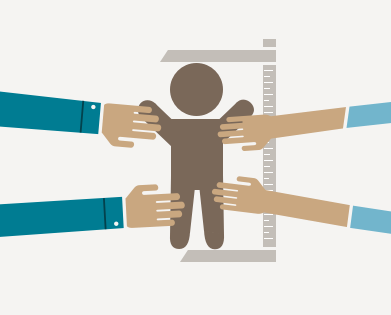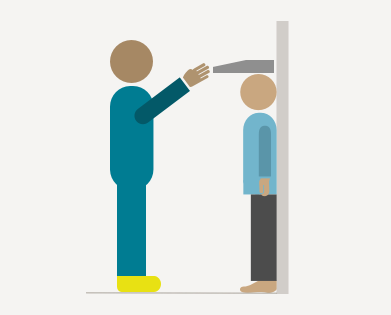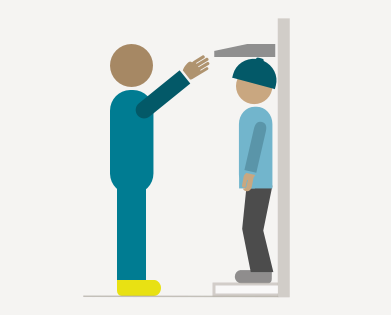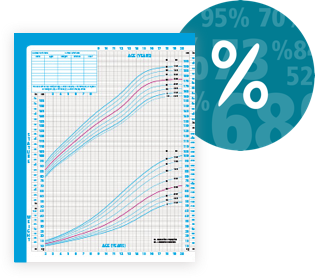To effectively evaluate your child’s growth, the doctor depends on accurate measurement and regular plotting on a growth chart. Let’s explore the proper equipment and procedures, so you’ll know your child is being measured accurately.
5 things every parent should know about how their child is measured.


Correct measuring equipment matters.

Correct measuring equipment matters.
Infants and toddlers up to 2 years of age
Children 2 years and older
Preparing your child for measuring is key.

Preparing your child for measuring is key.
- Remove baby’s clothing
- Remove bigger kids’ shoes, socks, and outer clothing
- Hair accessories or hats should be removed
- Undo hairstyles that could interfere with measuring
- Remove or loosen baby’s diaper to allow for extension of their legs
Proper measuring procedures are essential.

Proper measuring procedures are essential.
- Two people are required, and infant should never be left unattended
- Infants are laid on their back with legs extended and head against the infantometer
- The infant’s head is held with chin up
- The ifant’s knees are gently pushed down and feet flexed against the infantometer and the length is recorded
- The procedure is repeated 3 times and results are averaged
This:


Not this:


- Children stand fully erect on a flat surface with their back against a vertical surface
- The child’s head is straight with eyes forward, chin level, and arms relaxed at their sides
- Heels are flat and feet together with the back of the head, shoulder blades, buttocks, and heels touching the flat surface
- The stadiometer headboard is moved onto the top of the head and height is recorded
- The measurement is repeated 3 times and results are averaged
This:


Not this:


Infants and toddlers up to 2 years of age
- Two people are required and infant should never be left unattended
- Infants are laid on their back with legs extended and head against the infantometer
- The infant’s head is held with chin up
- The infant’s knees are gently pushed down and feet flexed against the infantometer and the length is recorded
- The procedure is repeated 3 times and results are averaged

This:



Not this:


Children 2 years and older
- Children stand fully erect on a flat surface with their back against a vertical surface
- The child’s head is straight with eyes forward, chin level, and arms relaxed at their sides
- Heels are flat and feet together with the back of the head, shoulder blades, buttocks, and heels touching the flat surface
- The stadiometer headboard is moved onto the top of the head and height is recorded
- The measurement is repeated 3 times and results are averaged

This:



Not this:


Measuring mistakes sometimes happen.

Measuring mistakes sometimes happen.
Now you’re familiar with the proper equipment, preparation, and procedures for measuring your child. Here are a few examples of common measuring errors to look out for that may lead to inaccuracies:
Marking the exam table paper to measure an infant’s length – this method can result in inaccuracies when the paper moves or bunches up.
Not asking for the child’s shoes and socks to be removed or hairstyles to be undone – these steps help ensure accurate measuring.
Measuring the child with the standing scale – this method makes it difficult for a child to stand with their back, shoulders, hips, and heels against the backboard.

Did you know?
According to a study that observed 307 children being measured in doctor’s offices at baseline, approximately 70% of those children were measured inaccurately. Accurate measurements were determined by pediatric endocrine nurses using correct equipment and technique.

Did you know?
According to a study that observed 307 children being measured in doctor’s offices at baseline, approximately 70% of those children were measured inaccurately. Accurate measurements were determined by pediatric endocrine nurses using correct equipment and technique.

Growth charts can be confusing.

Growth charts can be confusing.


Example of a growth chart
Example of a growth chart
Growth charts are tools that provide an overall picture of your child’s growth—but they can be confusing. If you find yourself wondering what exactly those dots, curves, and percentiles mean, you’re not alone. Let’s break it down:
All charts are not the same. Charts are for either boys or girls, and for up to 2 years or over 2 years of age.
Plotting = dotting. Your child’s height and weight are “plotted” when the doctor or nurse places a dot at the appropriate point on the proper growth chart, based on their age in months or years.
Curves to compare. Various percentile curves are included to illustrate how your child’s measurement compares to other children of the same age
Percentiles get all the attention. Percentiles are a quick way of comparing your child’s growth to that of other children of the same age. Learn the definition of percentile.
Growth-related terms you may hear at the doctor’s office.
Questions about growth disorders?
Arm yourself with knowledge about medical conditions that can affect growth.
Is it time to talk to the doctor?
Learn why, when, and how to talk to your child’s doctor about growth.


Why is accurate measurement important?
Precise measuring helps the doctor accurately assess your child’s growth. Incorrect measurements, like measurements above or below your child’s actual height, mean errors in their growth chart. This may lead to delays in diagnosing medical conditions that affect growth.
Should my child be in the 100th percentile for height?
Scoring 100% on a test is terrific, but it’s not necessarily the goal when it comes to your child’s growth. For example, if your daughter is in the 60th percentile for height, it’s not “good” or “bad.” It just means that 60% of girls her age are shorter than her.
Stay up-to-date with information from Novo Nordisk.
• Learn more about growth disorders
• Get related news and updates
Stay up-to-date with information from Novo Nordisk.
• Learn more about growth disorders
• Get related news and updates








